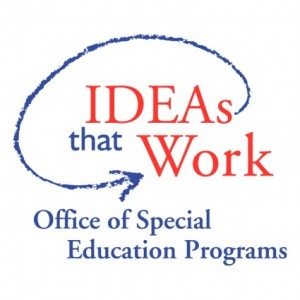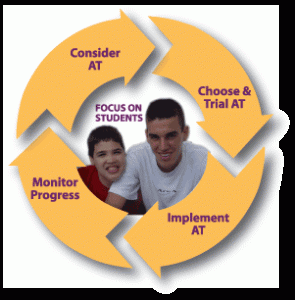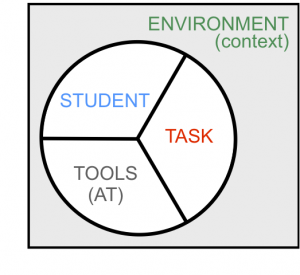That depends.
On the task, the person doing it, and the environment in which the task will be done.
Technology options are changing at a dizzying pace.
Your child’s skills, needs, and priorities are changing too. Soon s/he will be learning, working, and living in new environments.
What assistive technology (AT) will work best?
Here are trusted free resources for planning AT solutions.
All that glitters in not gold
Shiny new devices and apps clamor for our attention.
Too often, we’re wooed into impulsive decisions by the hype, popularity, or “wow-factor” of new technologies. But this can lead to disappointment and frustration if the nifty tool doesn’t do the job, or takes more effort than expected.
An AT solution is golden only if it does the job that needs doing, in a way that works well for your child, in the environment where he’s learning, working and living.
A process
The Johns Hopkins University Center for Technology in Education looks at assistive technology planning as an ongoing process. They call it the “AT Cycle”
It begins by looking at the student’s skills, goals, priorities, and needs.
What supports does the student need to accomplish high priority tasks?
The team:
- considers potential AT options
- chooses AT to trial
- selects AT to implement based on trial data
- monitors the student’s progress over time
You can learn more about the John’s Hopkins AT Cycle here.
Details, please!
Choosing an AT solution requires attention to detail.
How can your team know what questions to ask and where to begin?
The Wisconsin Assistive Technology Initiative (WATI) provides well-respected, free resources.
At WATI’s Free Publications Page, you’ll find structured planning tools with guiding questions that will help your team identify specific AT support needs related to:
- Communication
- Seating, Positioning & Mobility
- Computer Access
- Writing
- Reading
- Math
- Organization
- Recreation & Leisure
- Activities of Daily Living
WATI’s Free Publications Page also includes planning tools for people with specific disabilities, as well as guidance for implementing AT trials and obtaining AT funding.
When using WATI tools, be sure to read the introductions and directions that help the team understand context and considerations.
The WATI tools that support group decision-making are based on the well-respected SETT (Student, Environments, Tasks & Tools) frame work developed by Joy Zabala.
Quality Standards
The QIAT (Quality Indicators for AT Services) Community is a grass-roots organization devoted to identifying, disseminating, and implementing quality standards for AT services. The group includes professionals and users of AT.
A basic assumption of QIAT is that AT efforts, at all stages, will involve collaborative work by teams including the student, family and professionals.
QIAT indicators are validated by research and address eight areas:
- Consideration of AT Needs
- Assessment of AT Needs
- AT in the IEP
- AT Implementation
- Evaluation of Effectiveness of AT
- AT and Transition
- Administrative Support for AT
- AT Professional Development
Family resources 
The Family Center on Technology and Disability (FCTD), funded by the Office of Special Education Programs (OSEP), offers a wealth of family-friendly resources.
At the FCTD website, you’ll find fact sheets, family guides, presentations, and more. Their Resource Review Database includes more than 1200 resources that can be searched by topic, disability, or type of resource.
You’ll find FCTD’s Family Information Guide to Assistive Technology and Transition to be extremely helpful as you and your child look ahead and plan for life after IEPs.
This FCTD guide helps you consider postsecondary education and employment environments, funding considerations, AT training and device maintenance, agency collaboration, and your child’s self determination in relation to assistive technology.
As you read this guide, you’ll learn about the importance of a transition portfolio that includes assistive technology information. Wonder what that might look like? Here’s a very comprehensive, free, example: WATI Student Resource Guide & Portfolio.
Your turn
There are way too many resources in this post to explore in one sitting. Don’t feel overwhelmed.
Plan a time to sit down and review the resources with someone who can help you decide on the next step you and your child can take toward assistive technology planning.
Have you used any of these resources? Are there other resources you’d like to suggest? We’d love to hear from you in the comments. Let’s learn together!
Find this post helpful? Please share it. Thanks!
All the best to you and your child as you travel the journey - one day at a time.
Graphics Credits: Johns Hopkins University, TechPotential.net , Office of Special Education Programs IDEAs that Work
You might also be interested in this post: Bookshare & Learning Ally - Text Access Solutions





{ 4 comments… read them below or add one }
Regarding your comment: “There are way too many resources in this post to explore in one sitting. Don’t feel overwhelmed. Plan a time to sit down and review the resources with someone who can help you decide on the next step you and your child can take toward assistive technology planning.”
I DO feel overwhelmed - with all of it. And there doesn’t seem to be anyone out there to sit down with me and help me decide on the next step.” I’ve been doing this for 15 years, by my self, and I am exhausted.
Eileen, your heartfelt words touch me deeply. None of us can travel the journey of life alone. We need each other, especially when we feel tired and overwhelmed. Growing a support network isn’t easy, but it is possible. Step by step. Let’s connect via email. I care. Other people do, too. You are not alone. Blessings to you and your child.
Assistive technology is a huge undertaking and it makes total sense that anyone would be overwhelmed. Mary is wise to advise not to try and take it all on yourself.
One contributing factor to the overwhelm is that identifying relevant assistive technology is a dynamic process, one that must be repeated several times over a lifetime. I am sure you have experienced that technology needs can change as a person’s situation changes, there are new challenges, and where the technology is intended to be used. The good news is that as you go through this process, you gather trusted resources, make connections with knowledgeable people and therefore build your essential support network. For example, you found Mary!
A tip that may help is to keep your focus on your goal, not the technology. It is by getting specific about what your needs are, what you need to accomplish, that will help identify the technology. I will use the example of reading. If your needs are to be able to read a textbook and your disability is a barrier, then there are specific assistive technology programs that can help read the book to you. If your needs are to physically hold the book, then there are devices that will do that for you. Perhaps you have both needs and then both types of technology are needed. My point is that with clarity of your specific needs, we can pinpoint the nature of the technology we are looking for. By narrowing down our focus, it can make the use of the vast resources a bit easier to navigate.
My intention here is to give you encouragement in this huge undertaking. If I can be of any assistance along with what Mary has offered, please feel free to contact me. [email protected]
Thanks for sharing valuable insights and encouragement, Bridgett!